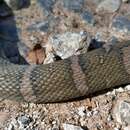Distribution
provided by EOL authors
This species is known from the Mekong River drainage in Laos, Cambodia, and Thailand. Deuve (1970) reported it in the Ngum River Valley of Laos. Taylor & Elbel (1958) describe specimens from Thailand’s Phan Phu Mountain, and Stuart et al. (2006) reported it from Siem Pang and Ta Veng in eastern Cambodia in bamboo mixed with evergreen forest between 100 and 170 m ASL. All of these localities are peripheral to the Mekong. However, Bezuijen et al. (2009) report it from the Mekong River in Kratie Province, Cambodia. They describe four specimens, one in a market, and three others at Koh Kapeung and Koh Khlap Islands, the largest was 104 cm in total length. One of these snakes was on a mud substrate.
Distribution
provided by EOL authors
This species is known from the Mekong River drainage in Laos, Cambodia, and Thailand. Deuve (1970) reported it in the Ngum River Valley of Laos. Taylor & Elbel (1958) describe specimens from Thailand’s Phan Phu Mountain, and Stuart et al. (2006) reported it from Siem Pang and Ta Veng in eastern Cambodia in bamboo mixed with evergreen forest between 100 and 170 m ASL. All of these localities are peripheral to the Mekong. However, Bezuijen et al. (2009) report it from the Mekong River in Kratie Province, Cambodia. They describe four specimens, one in a market, and three others at Koh Kapeung and Koh Khlap Islands, the largest was 104 cm in total length. One of these snakes was on a mud substrate.
Brief Summary
provided by EOL authors
The Mekong Masked Water Snake was described by Deuve (1970) based on specimens from the Ngum River Valley, Laos. He reported reported snakes with 35–39 scale rows at midbody, 152–164 ventrals and 75–pale spots on each side, subcaudals. It differs from other members of the genus in having a dark belly with paired pale spots. Little is known about its life history or geographic distribution. However, its distribution appears to be peripheral to the Mekong River, and it seems to use streams with rocky substrates, and like other members of the genus it probably is nocturnal and feeds on fish.
Taxonomy
provided by EOL authors
Homalopsis buccata nigroventralis Deuve, 1970 was raised to species status by Stuart et al. (2006), Murphy (2007) provided a more detailed description and the species level status of this snake was further confirmed in the most recent review of the genus (Murphy et al. 2012)

